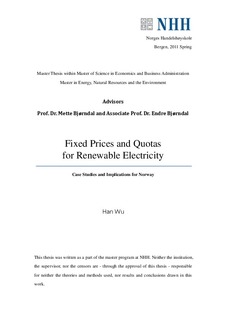| dc.contributor.author | Wu, Han | |
| dc.date.accessioned | 2011-10-05T09:35:48Z | |
| dc.date.available | 2011-10-05T09:35:48Z | |
| dc.date.issued | 2011 | |
| dc.identifier.uri | http://hdl.handle.net/11250/169005 | |
| dc.description.abstract | This thesis provides a study on the support schemes for renewable electricity generation. In particular two schemes, namely Feed-in Tariff (FIT) and Tradable Green Certificate (TGC), are compared. The author analyzes the applications of the two schemes in the wind power markets of four different countries and takes a further look at the common certificate market that Norway and Sweden will enter in 2012. The country case studies reveal that the FIT system has advantages in stimulating new capacity, reducing risk and utilizing resources, while the TGC system ensures cost control and performs efficiently in meeting a policy goal within a limited time frame. The future Norwegian-Swedish common TGC market can help Norway to further utilize its hydropower resources and fulfill the international obligations. However, it should be aware that the technology-neutral design of the system may create windfall profit for lower-cost generators and thus lead to an allocation problem. | en |
| dc.language.iso | eng | en |
| dc.subject | energy, natural resources and the environment | en |
| dc.title | Fixed prices and quotas for renewable electricity : case studies and implications for Norway | en |
| dc.type | Master thesis | en |
| dc.subject.nsi | VDP::Samfunnsvitenskap: 200::Økonomi: 210::Samfunnsøkonomi: 212 | en |
